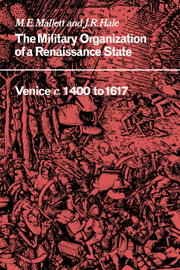Book contents
- Frontmatter
- Contents
- List of illustrations
- Acknowledgements
- References and abbreviations
- Map 1 The Terraferma in the fifteenth and sixteenth centuries
- Map 2 The empire da Mar
- PART I c. 1400 to 1508
- Introduction: the European context 1400–1525
- 1 The beginnings of Venetian expansion
- 2 The composition and role of the army in the fifteenth century
- 3 Military development and fighting potential
- 4 The organization and administration of the Venetian army
- 5 Control and policy making
- 6 Soldiers and the state
- 7 Venice and war
- PART II 1509–1617
- Conclusion: the European context 1525–1617
- Appendix Infantry wages in the sixteenth century
- Select bibliography
- Index
1 - The beginnings of Venetian expansion
Published online by Cambridge University Press: 22 October 2009
- Frontmatter
- Contents
- List of illustrations
- Acknowledgements
- References and abbreviations
- Map 1 The Terraferma in the fifteenth and sixteenth centuries
- Map 2 The empire da Mar
- PART I c. 1400 to 1508
- Introduction: the European context 1400–1525
- 1 The beginnings of Venetian expansion
- 2 The composition and role of the army in the fifteenth century
- 3 Military development and fighting potential
- 4 The organization and administration of the Venetian army
- 5 Control and policy making
- 6 Soldiers and the state
- 7 Venice and war
- PART II 1509–1617
- Conclusion: the European context 1525–1617
- Appendix Infantry wages in the sixteenth century
- Select bibliography
- Index
Summary
The rapid creation of a Terraferma state by Venice in the first three decades of the fifteenth century gives an impression of a new orientation of Venetian policy which is very misleading. The appearance of the Lion of St Mark, the symbol of Venetian authority, on city walls and town halls from the banks of the Adda in the west to the Isonzo in the east, and from the foothills of the Alps to the Po, seemed a dramatic extension of the power and influence of the lagoon republic. There were many at the time, and have been since, who spoke of Venetian imperialism shifting its emphasis sharply from east to west in the face of an irresistible Turkish advance and a consequent decline of Levantine commercial interests. But this is to exaggerate both the power of the Turks in the early fifteenth century and their impact on eastern Mediterranean trade, and the novelty of Venice's interest in the Italian mainland. Direct rule replaced covert economic and diplomatic influence as the method of Venice's role in northern Italy in the early fifteenth century, but the innovations were institutional rather than political, and particularly were they apparent in military institutions. The creation of a standing force to protect the newly, acquired state was the real novelty of the period; the involvement which led to that development has to be traced back much further.
Throughout the thirteenth and fourteenth centuries Venice had kept a careful watch on affairs in northern Italy.
- Type
- Chapter
- Information
- The Military Organisation of a Renaissance StateVenice c.1400 to 1617, pp. 7 - 19Publisher: Cambridge University PressPrint publication year: 1984



